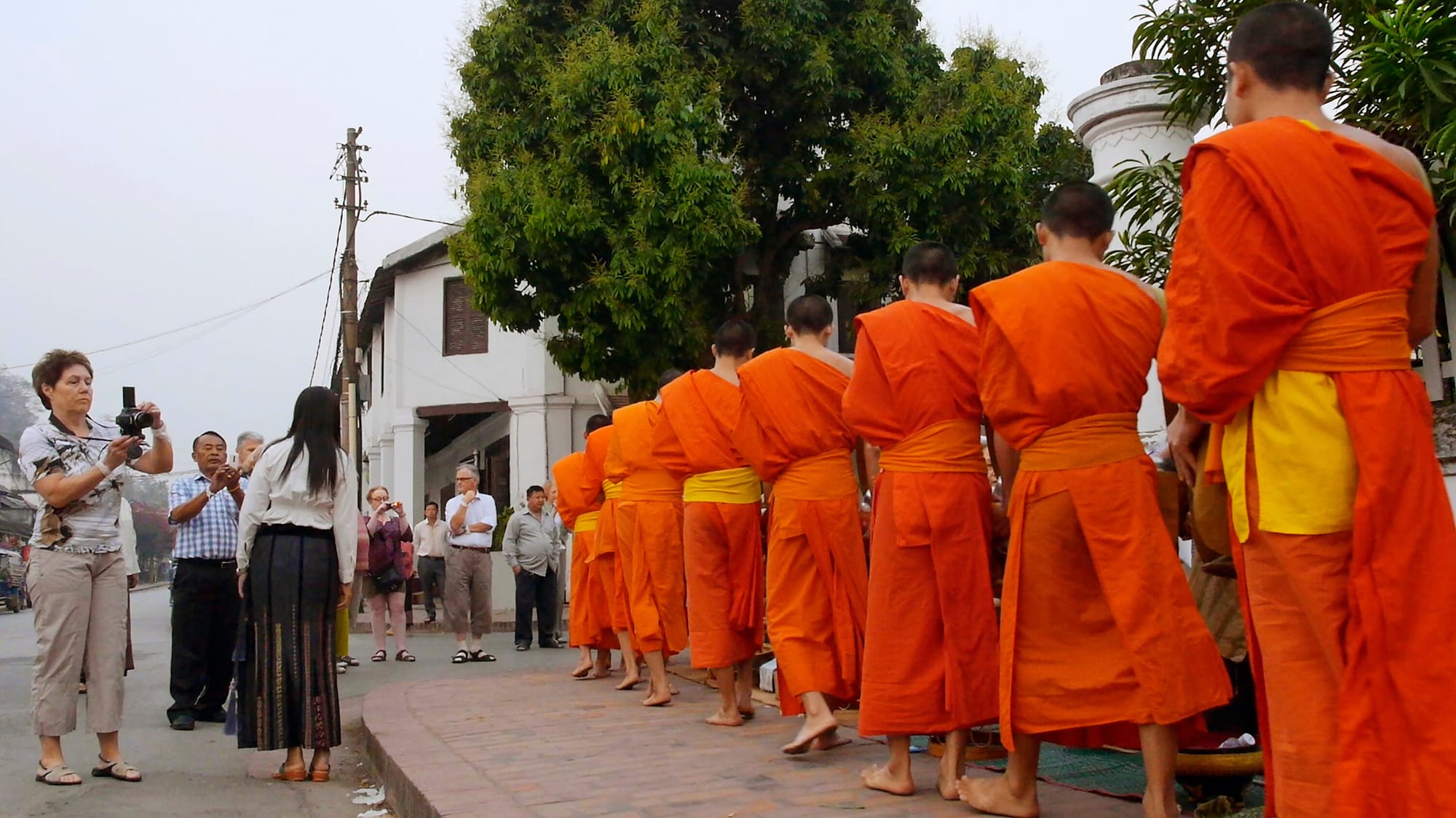Onlookers (Kimi Takesue, 2023)

Onlookers is an observational documentary by American filmmaker Kimi Takesue. Over a quick 72 minutes in a series of static shots almost entirely lacking in dialogue, she paints a portrait of a small Laotian village, one whose gorgeous riverside landscapes and picturesque monasteries serve to attract tourists from around the world. Alternating freely and at times pointedly between images of the local inhabitants, visitors from abroad, and the local environment, Takesue explores the complex relationship between tourists and the toured. It’s impossible, while watching boatloads of (mostly but certainly not entirely) pasty visitors overloaded with luggage pile into a small, picturesque community, to not catch the parallels between tourism and colonialism. The difference being that while colonists work to extract the material resources of the colonized, what tourists are after are sensations: the sounds and smells and sights of the far off places they visit. But just as with material extraction, sensational extraction inevitably transforms the toured locations. Not just in that their economies bend to the demands of outsiders: hotels, bars, restaurants, guides and recreational activities, but in the kind of world-flattening way that, for better and worse, makes a mishmash of all culture (monks smoking cigarettes, little girls wearing Elsa backpacks to school, a reggae bar serving pizza and Mexican food).
While the visual style is familiar: Frederick Wiseman is there, of course, but also the sly humor of Tsai Ming-liang’s Walker shorts, and perhaps most tellingly, the Harvard Sensory Ethnography Lab, specifically JP Sniadecki and Libbie Cohn’s 2012 film People’s Park, in which a camera is wheeled around a public park in Chengdu, China over a single afternoon. While People’s Park is shot in a single-take, unlike Takesue’s elaborate montage, the perspective—a camera watching people at play—is similar. Takesue though twists Sniadecki and Cohn’s work by, in effect, turning the camera on the visitors: both the locals and the tourists are subject to the same ethnographic scrutiny. It’s telling that, while the Laotians always seem aware of the camera crew, they constantly look back at it, smiling or joking with their friends about its appearance, the tourists only rarely ever seem to notice or care about it. Maybe they just assume that it’s only natural that cameras would be there to document their lives, because they are, in their own minds, the main characters of the world. Or maybe they’re just used to it because so much of modern advanced capitalist culture revolves around being surveilled and, in turn, taking pictures of everything.

That’s mostly what these tourists do. They climb mountains not for the view itself, but for the view to serve as a backdrop for a selfie. They visit a gorgeous cascading waterfall to pose for and take pictures by it. A local appears to be using the waterfall as a fishing hole, but he too is quickly subsumed into the demands of the photographer. Probably quite willingly: he certainly seems to delight in posing for the camera, and that may even be his real purpose for walking into the water with his fishing pole, rather than the practical desire to catch some supper. When they aren’t taking pictures of themselves, or of themselves standing by much more beautiful things, the tourists lounge about. There’s a whole contingent of vacationers who treat the village like any spring break spot anywhere in the world: the lounge about in swimming gear, float on the water drinking beer, or hang around the hotel watching Friends on TV. Tourism may be a net benefit to a community, its material effects can often be a major boon to otherwise desperately poor places, but aesthetically it tends to take the most remote and beautiful places in the world are turn them into Fort Lauderdale.
Finally though, the most wonderful thing about this very fine film are its subtitles for the deaf and hard of hearing. Credited on the film’s website to Cheryl Green, they are quite simply the most beautiful and poetic captions I’ve ever seen. Scene after scene plays out like a little haiku, adding an undeniably sardonic and wistful edge to this very playful film. Some examples:
Symphony of songbirds echoing
Line zips and whines
Grating whine of pulley nears, rising in pitch
Whining grinds to a halt - “Ugh!”
Traffic pulses, roars
“Friends” on TV speak English
TV voices buried under rush of traffic
Hiss and whine of insects, birds singing
Pulsing dance music, chatting crowds
Cheering, applause
Gentle slosh of water
Cheerful children, quiet conversations
Stone plops into water
Children cheer
And on and on and on. They’re incredible.
The movie, after a lengthy festival run last year (Slamdance, Cinéma du Réel, the San Diego Asian Film Festival, Prismatic Ground, etc) and a theatrical premiere this past week at the Metrograph as part of their Fire Over Water: Films of Transcendence series (where it was paired with movies like Kaili Blues, Cemetery of Splendour The Red Turtle and Inside the Yellow Cocoon Shell), will be available on the Metrograph at Home streaming platform starting February 23. Watch it with the captions on.
